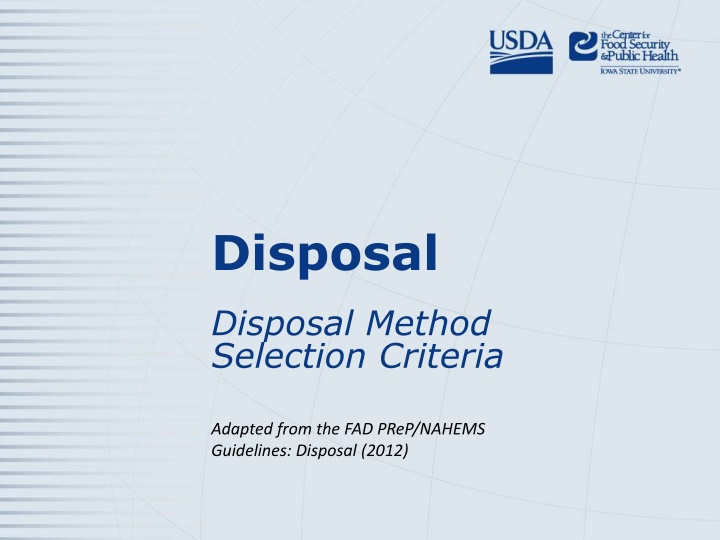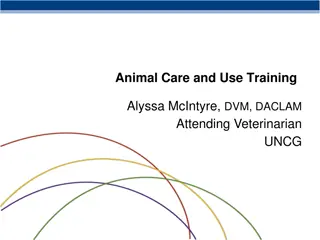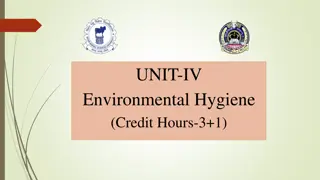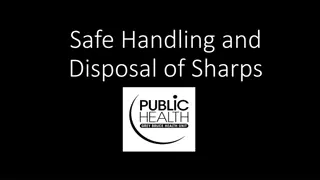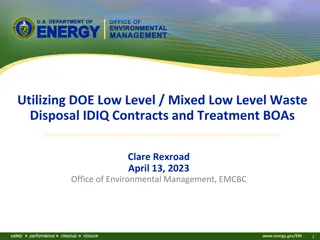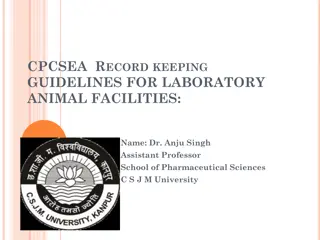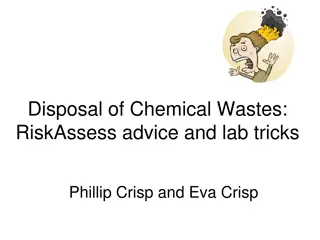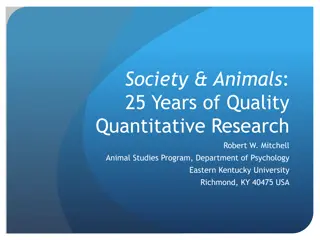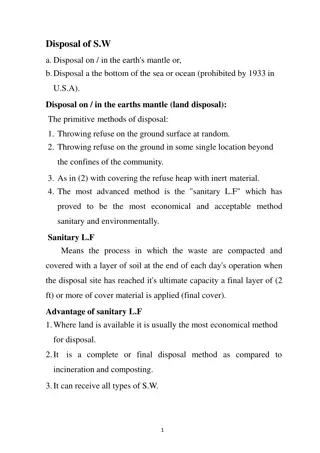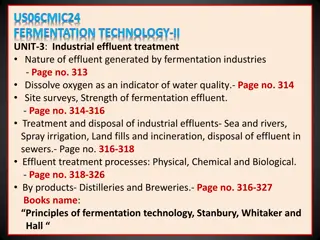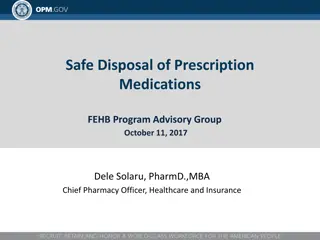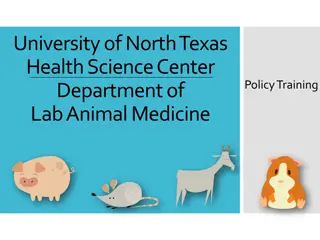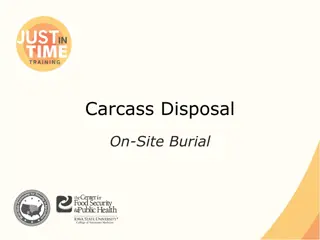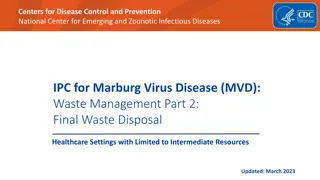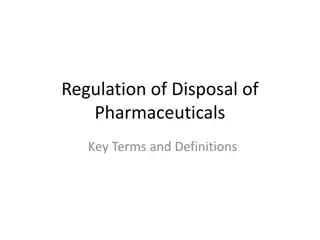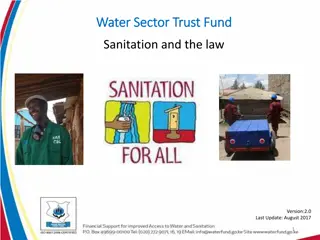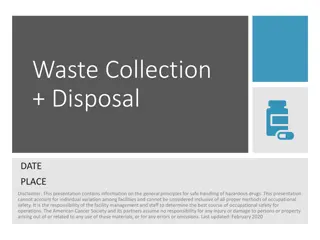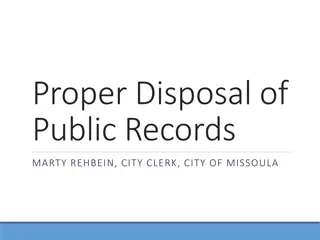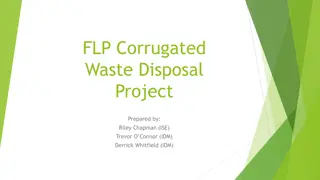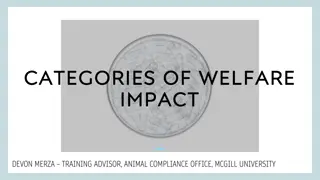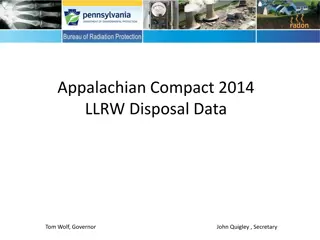Guidelines for Animal Disposal Methods
Environmental and biosecurity guidelines recommend various disposal methods such as composting, rendering, permitted landfill, unlined burial, fixed-facility incineration, and open-air burning. Each method has specific selection criteria and considerations to minimize risks to the environment and biosecurity. Composting involves low risk of contamination but requires proper site selection and testing. Rendering involves transportation to a facility and handling, with the end product generally safe but not suitable as feed. Permitted landfills require systems for collection and adjustments, with biosecurity risks in transportation and carcass handling. Unlined burial poses risks of water contamination and long-term monitoring. Fixed-facility incineration utilizes emission control devices, ash disposal, and inactivates prions. Open-air burning has negative impacts on air and water quality, as well as soil contamination.
Download Presentation

Please find below an Image/Link to download the presentation.
The content on the website is provided AS IS for your information and personal use only. It may not be sold, licensed, or shared on other websites without obtaining consent from the author.If you encounter any issues during the download, it is possible that the publisher has removed the file from their server.
You are allowed to download the files provided on this website for personal or commercial use, subject to the condition that they are used lawfully. All files are the property of their respective owners.
The content on the website is provided AS IS for your information and personal use only. It may not be sold, licensed, or shared on other websites without obtaining consent from the author.
E N D
Presentation Transcript
Disposal Disposal Method Selection Criteria Adapted from the FAD PReP/NAHEMS Guidelines: Disposal (2012)
Environmental and Biosecurity Considerations FAD PReP/NAHEMS Guidelines: Disposal - Disposal Method Selection Criteria USDA APHIS and CFSPH
Composting Low risk of environmental contamination Proper site selection Well-compacted soil Appropriate cover Potential for nitrogen release Indoor composting protected Biosecurity risks Test compost before transporting FAD PReP/NAHEMS Guidelines: Disposal - Disposal Method Selection Criteria USDA APHIS and CFSPH
Rendering Environmental regulation Biosecurity risks Transportation to rendering facility Handling at rendering facility End product is generally safe Some pathogens or toxins may not be completely eliminated Rendered carcasses not used as feed May be safe for landfills FAD PReP/NAHEMS Guidelines: Disposal - Disposal Method Selection Criteria USDA APHIS and CFSPH
Permitted Landfill Output: leachate and landfill gas Landfills Systems in place for collection Adjustments may be necessary Biosecurity risks Transportation Carcass handling FAD PReP/NAHEMS Guidelines: Disposal - Disposal Method Selection Criteria USDA APHIS and CFSPH
Unlined Burial Potential water contamination Pathogens are not inactivated Long term monitoring, management, environmental testing Environmental remediation, if necessary FAD PReP/NAHEMS Guidelines: Disposal - Disposal Method Selection Criteria USDA APHIS and CFSPH
Fixed-Facility Incineration Emission control devices Ash disposal from closed container Biosecure transport and handling Temporary storage, if capacity exceeded Inactivates prions FAD PReP/NAHEMS Guidelines: Disposal - Disposal Method Selection Criteria USDA APHIS and CFSPH
Open-Air Burning Negative impact on air quality and water sources Soil contamination from accelerant Ash disposal Pathogen may be dispersed in smoke Public nuisance, unintended fires, and violations of regulatory restrictions FAD PReP/NAHEMS Guidelines: Disposal - Disposal Method Selection Criteria USDA APHIS and CFSPH
Air-Curtain Incineration Relatively clean-burning Can be set up on-site Fewer air pollutants than open-air burning Refractory box protects the ground at the site from ash Biosecure delivery of fuel FAD PReP/NAHEMS Guidelines: Disposal - Disposal Method Selection Criteria USDA APHIS and CFSPH
Site-Specific Disposal Method Selection Criteria FAD PReP/NAHEMS Guidelines: Disposal - Disposal Method Selection Criteria USDA APHIS and CFSPH
Regional Limitations Consult authorities to minimize negative effects Environmental Pubic health Other regulations Consider local geophysical conditions and climatic trends FAD PReP/NAHEMS Guidelines: Disposal - Disposal Method Selection Criteria USDA APHIS and CFSPH
Safety Considerations Safety Officer provides guidance in disposal site selection All personnel should be trained OSHA recommendations for people working in hazardous waste operations involving pathogens CFR, Part 21, Chapter 1910 FAD PReP/NAHEMS Guidelines: Disposal - Disposal Method Selection Criteria USDA APHIS and CFSPH
Animals to be Disposed Biomass Personnel needed Necessary equipment Type/species/number Potential by-products also requiring disposal E.g., dairy cows and milk FAD PReP/NAHEMS Guidelines: Disposal - Disposal Method Selection Criteria USDA APHIS and CFSPH
Temporary Storage Carcass disposal ideally occurs within 24 hours of depopulation Temporary storage may be necessary in an animal health emergency EPA regulations may apply Storage options Refrigeration in closed building Grinding and preserving carcasses Trenches, silos, pits FAD PReP/NAHEMS Guidelines: Disposal - Disposal Method Selection Criteria USDA APHIS and CFSPH
For More Information FAD PReP/NAHEMS Guidelines & SOP: Disposal (2012) http://www.aphis.usda.gov/animal_ health/emergency_management/ Disposal web-based training module http://naherc.sws.iastate.edu/ FAD PReP/NAHEMS Guidelines: Disposal - Disposal Method Selection Criteria USDA APHIS and CFSPH
Guidelines Content Authors Rene Dewell, DVM, MS (CFSPH) Tom Glanville, PhD (Iowa State University) Significant contributions to the content were provided by USDA APHIS VS: Lori P. Miller, PE Darrel K. Styles, DVM, PhD FAD PReP/NAHEMS Guidelines: Disposal - Disposal Method Selection Criteria USDA APHIS and CFSPH
Acknowledgments Development of this presentation was by the Center for Food Security and Public Health at Iowa State University through funding from the USDA APHIS Veterinary Services PPT Author: Kerry Leedom Larson, DVM, MPH, PhD, DACVPM Reviewers: Janice Mogan, DVM; Rene Dewell, DVM, MS
